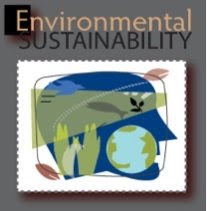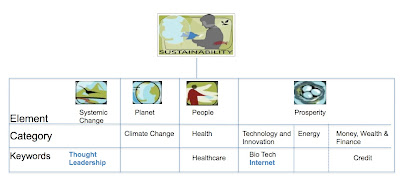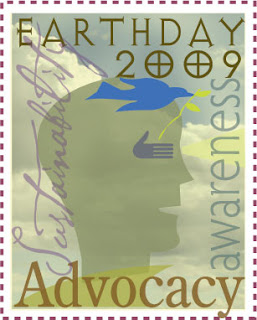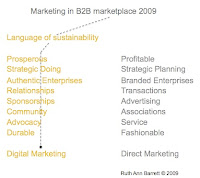
A recent research report by The Hartman Group entitled Sustainability: the Rise of Consumer Responsibility by Alice Worthington, Spring 2009, is a must read for companies in the B2C space. It confirmed what we here at EarthSayers.tv have found: Consumers interpret the word, sustainability, as green and link it to only one zone, environmental. And it’s not just consumers.
We found even business people with a “for benefit” mission and green products are likely to express the same narrow definition.
As a way to overcome this misunderstanding and as part of our intent to increase sustainability awareness with the project, EarthSayers.tv, we created a taxonomy of sustainability and called it a content map.
The taxonomy defines four elements of sustainability – overview/systemic change, planet, people, and prosperity. There are over twenty-three categories falling within these four categories with all key words, over 300, rolling up to category to element. This is very useful tool for companies to use in creating sustainability as a business strategy and to put the wood behind one arrow. For example, we took a laundry list of socially responsible projects we found on the Website of a major consulting firm and re-organized the pieces and parts into a sustainability strategy.
Laundry List of Causes or Programs
Biotechnology
Climate Change
Credit Crisis
Energy
Geopolitics
Globalization
Health Care
Innovation
Internet
This particular company has not developed a though leadership platform around sustainability, a key to the element, systemic change (one of their principals speaks on broad economic issues) and has a hit and miss strategy for the planet and people. They have a presence in the prosperity category, as do many venture capital companies do, but it suggests they are covering bets, rather than working towards sustainable development. Laundry list as strategy:
Moving from laundry lists to coherent sustainability strategy is the first step in being able to convince consumers, both B2C and B2B that the company is a responsible, with core values around sustainability, and activities which are consistent with these values. As noted in the Hartman study, “sustainability is a marker of quality, and can be a tie breaker in a purchase decision.” For B2B companies, even high powered consulting and investment ones, it certainly will indicate to prospects and investors a higher level of transparency, responsibility, and accountability.









